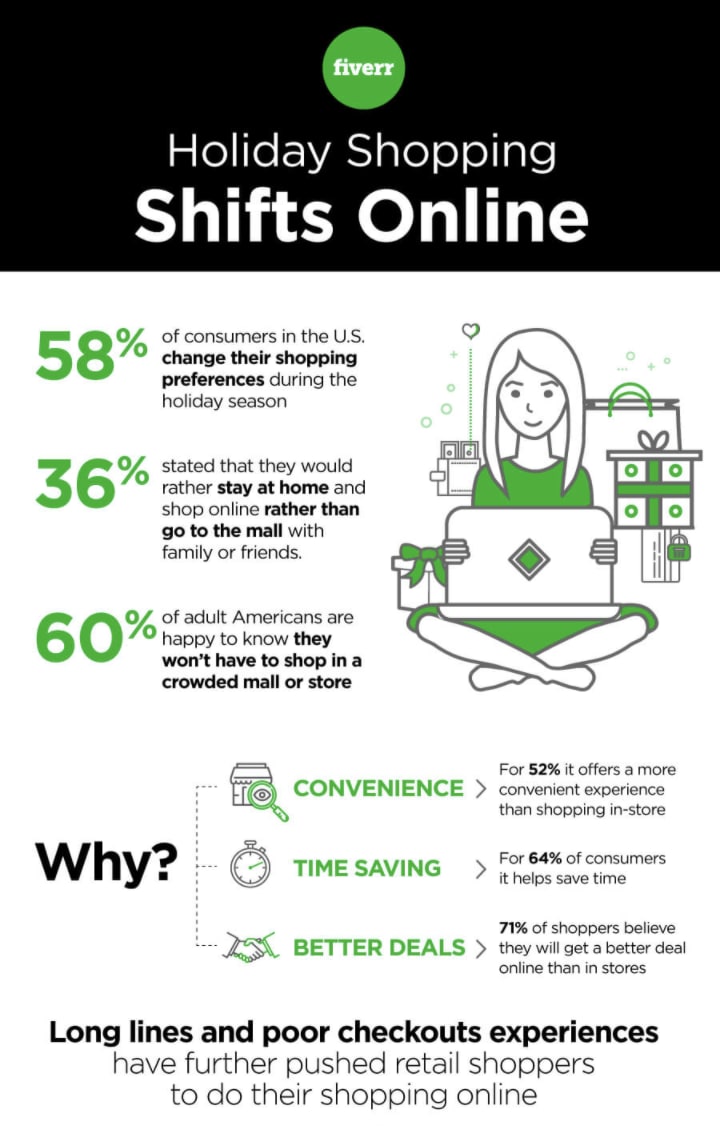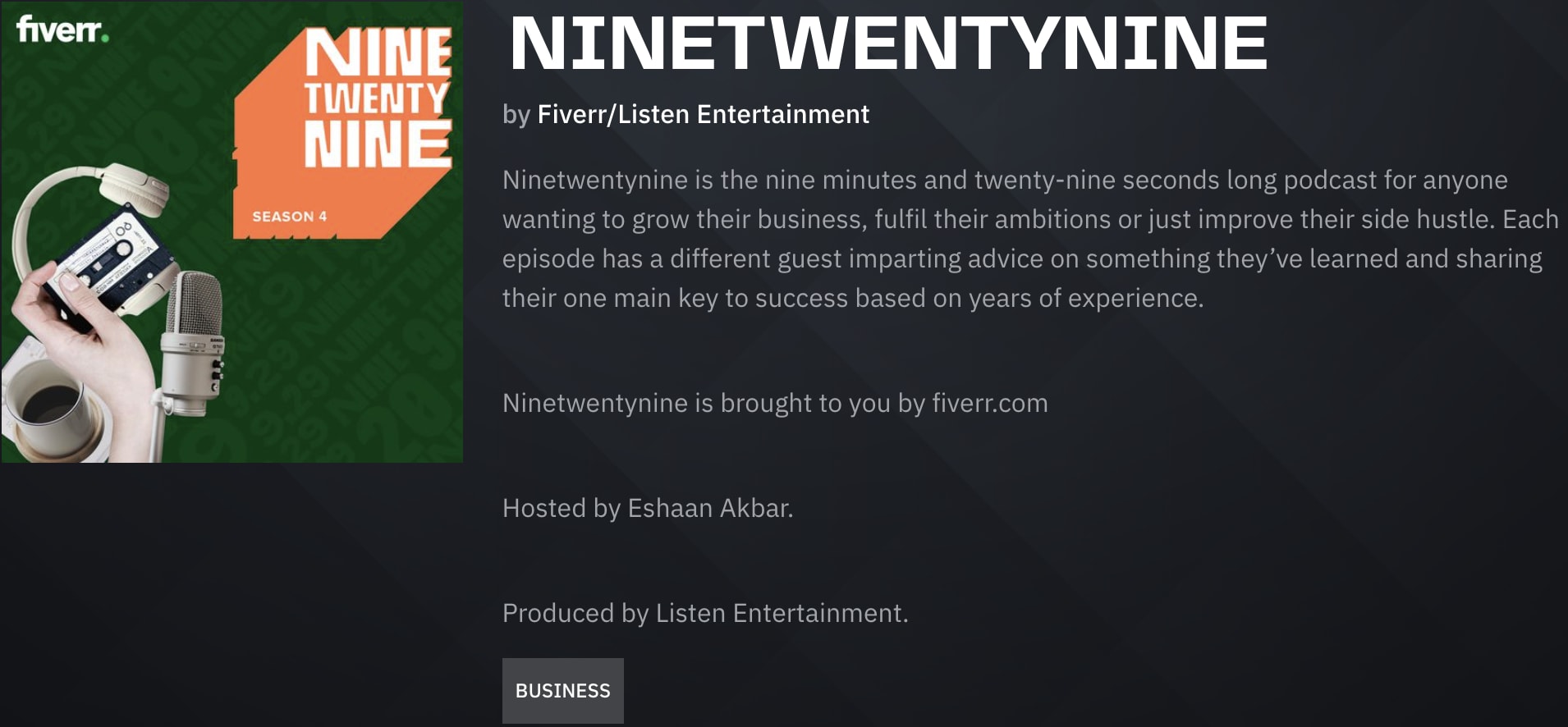What is content marketing?
Learn why content is important for your marketing
 November 7, 2021
November 7, 2021 8 minute reading
8 minute reading
Content marketing is a marketing strategy aimed to create an audience by publishing, maintaining, and distributing regular and consistent content that educates, entertains, or inspires. Considered to be an essential part of any business's success content marketing offers many benefits to companies of all sizes, including more leads and sales, a boost in brand awareness, increased customer retention, and so much more.
Yet, many small businesses aren't correctly harnessing the powers of content marketing—mainly because they lack the time, resources, or knowledge to do so. In 2021, the majority (82%) of marketers are actively using content to attract and retain their target audiences and turn them into loyal customers. Therefore, if you want your business to stand out from your competitors, you too mustutilize this marketing strategyor risk being left behind.
We've created this in-depth and actionable guide to help you understand what content marketing is and why it's important. You'll learn about the different content marketing channels, how to get started, measure your content performance, and more.
Content Marketing Explained
1. What is content marketing?
Content marketing is a strategic marketing approachthat involves creating and distributing valuable, relevant, and consistent content. This content aims to attract and retain a brand's target audience, leading to a boost in brand awareness, improved search engine rankings, and increased profitable customer actions.
This content might take the form of a blog post, article, webpage, video, infographic, or podcast, for example.
Rather than just pitching their products or services to their target consumers, businesses use content marketing to provide valuable and relevant content to assist them in solving their problems.
This is how content marketing differs from other forms of marketing and advertising, as it must provide value. Simply put, content marketing isn't about your brand or the products or services you offer. Instead, content marketing is about your audience and what they care about.
As a result, a successful content marketing campaign is one people seek out orwantto engage with rather than avoiding it. It doesn't involve traditional marketing efforts a company would use to market their products or services, such as sales collateral. Instead, content marketing takes a specific question or problemyour target audience hasand turns it into an educational, actionable, and highly relevant piece of content that audiences can't get anywhere else.
2. Why is content marketing important?
Content marketing is extremely important for businesses; however, it has never been so crucial as it is now. In our current digital era, well-known brands dominate the online world and social media platforms have replacedtraditional advertising means. As a result, it is basically impossible to succeed as a business, both in the B2B and B2C spaces, without leveraging modern forms of content marketing.
Let's take a closer look at the ten reasons why content marketing is important for businesses.
1. Build brand reputation and trust through content marketing
In today's fast-paced and highly competitive world, brands must focus on building trust with their customers and leads, as this allows a business to form a positive brand reputation.
According to studies,70% of consumersprefer getting to know a company via content such as articles rather than advertisements. Additionally,90%的人认为公司提供原创内容are interested in developing good relationships with them.
It is through your content that consumers will form an opinion about your business. Therefore, if your content is valuable, helpful, and interesting, they will associate those same positive traits with your brand.
When your audience sees you regularly publishing high-quality and relevant content across a number of different platforms (including third-party channels), they begin to consider you as an expert within your industry.
2. Posting great content helps influence conversions
Did you know the website conversion rate is nearly six times higher for brands who utilize content marketing than those who don't?
当我们谈论转换,意味着当一个力itor takes an action such as:
making a purchase
obtaining more information
contacting your customer sales team
This action will be prompted through a CTA, or call to action, which you place in your content. Its purpose is to guide the reader toward an intended action.
Content marketing is vital for conversions because it also allows you to educate and connect with your leads on a deeper level. This gives them the information they need to make a more informed purchasing decision from your brand. After reading product recommendations on a blog, for example, 61% of online consumers in the U.S. have then gone on to make a purchase.
Additionally, according to 74% of companies surveyed, content marketing has enhanced both the quality and quantity of their marketing leads.
3. Optimized content helps improve your SEO efforts
Content marketing also plays an important role in building andimproving a brand's SEO(search engine optimization). SEO is important for businesses of all sizes, as it directly relates to how prominently their business is displayed online, along with how easy it is for others to find.
Statistics further prove just how much content creation and SEO go hand-in-hand.Brands posting regular content on their bloghave on average 434% more pages indexed by search engines than those that don't publish any blog content.
This is because more content published on your site results in more pages a search engine has to index and provide to users in their search engine results. However, it's essential to understand that more content pages on your website don't necessarily equate to more traffic. Instead, it allows you to potentially rank for more keywords that are relevant to your target audience. These are the queries, or words they are searching for.
Having more content on your brand's website gives visitors additional reasons to stay on your site, which further boosts your SEO. This is because a higher on-site time gives search engines such as Google an indication your website provides value.
4. Creating great content is a cost-effective way to bring in new leads
Lead generation is important for brandsbecause it allows them to boost their sales and grow their business.
你可能不知道,ab内容营销成本out 62% less than traditional marketing tactics but generates about 3 times as many leads.
Content creation should be strategic and have your target audience at the forefront of your mind, however, particularly in terms of:
Topics written about
Types of content produced
Promotional methods
5. Content enables your brand to showcase your expertise
Content marketing also allows your brand to showcase its expertise in your chosen field. This is vital for consumers, as they want to feel assured they're buying from the best within the industry.
Through the content you publish, you're also able to demonstrate to your audience that you understand their greatest challenges and you can provide the solution to assist them in overcoming these.
When it's time for that visitor to make a purchase,your brand will instantly come to mind, thanks to the helpful and valuable content you provided them with earlier.
6. Great content encourages repeat customers
According to research, a loyal customer is worth up to 10x as much as their first purchase. Additionally, 61% of SMBs say half of their revenue is coming from repeat customers.
Remember, providing valuable content shouldn't end once a lead becomes a customer. This relationship should be further nourished by providing additional content that further strengthens your relationship with this consumer, such as how-to videos, brand guides, and product comparisons. These allow customers to continue making smart purchasing decisions.
7.高质量的内容给你领导和成本mers what they desire
Did you know 20% of internet users' time online is spent reading content and that 68% of people spend time reading about brands that interest them?
This is another great argument for the importance of content marketing, as it proves consumers actually enjoy engaging with a brand's content. However, in order to be successful, brands must ensure the content they publish is highly relevant to their target audience.
The best way to do this is by examining the data you collect from your audience. This might include journey maps, user feedback, vanity metrics, and customer demographics, for example.
It is then much easier to create content that is relevant to your target audience's needs, interests, and challenges.
8. Content marketing helps you set yourself apart from competitors
Content marketing is an efficient way that companies can set themselves apart from others in their industry. The content you create for your audience could make the difference between a consumer choosing your product or service over your competitor's, especially if your content shows readers how you can solve their challenge.
Additionally, content marketing plays a vital role in establishingyour brand personality and voice. For example, is your brand fun and quirky? Or serious and educational? Your content should convey this, along with any unique traits that set you apart from others within your industry.
9. Content is important during each step of the marketing funnel
There are three major areas of your marketing funnel that you need to think about while developing your content marketing campaigns: the top, middle, and bottom.
Top-of-Funnel (TOFU):Leads at the top of your funnel are at the very beginning of their customer journey. They are becoming aware of their challenges, along with the fact that solutions are available. During this early phase of the funnel, your content should be educational and provide them with the information they need to determine which solution might help them the most.
Middle-of-Funnel (MOFU):During the middle phase of your funnel, your leads are considering their options for the solution to their problem. Their aim is to narrow down their choices, so you'll want to share content with them that allows them to do this. This will help them reach a final purchasing decision, which takes us to the next phase in the marketing funnel.
Bottom-of-Funnel (BOFU):Leads at the bottom of your funnel are now ready to convert into a sale. Therefore, content distributed to these consumers should give them that final nudge they require to commit to the sale. This might include specific details about your unique offer or answering any questions they may still have in relation to purchasing your product or service.
10. Content helps support nearly every other digital marketing strategy
When it comes toa brand's digital marketing efforts, such as social media posts, PPC ads, email newsletters, and more, they all have one thing in common: they require great quality content to be successful.
In fact, you can think of content marketing as the glue that holds all of your marketing efforts together. Without great content, you only possess ideas, and these simply don't convert on their own.
3. How content marketing works
Content marketing works by providing readers with helpful and relevant material that offers value and insight about topics they are interested in. By using blog posts,social media updates, graphics, and videos, content marketing appeals to potential customers, attracts their engagement, and propels them further along the sales funnel.
It, therefore, comes as no surprise that more than three-quarters (76%) of marketers say they take a strategic approach to their brand's content. This means they put a more formal system in place for creating, managing, and assessing their content marketing, including the use of people, processes, and technologies that allow them to scale and deliver content.
As our online world becomes more saturated with content, this strategic approach is necessary for content marketing to truly work. As a result, businesses can expect to:
Improve customer experiences
Generate and nurture more leads
Aid the company's goals and benchmarks for success
4. Content marketing examples
Now that you've learned about the three key types of content marketing channels, let's look at some key examples of content marketing to further define what it is.
People often struggle with the concept of content marketing, however, it's useful to think about it in the following way. A stockbroker distributes a daily newsletter to their email subscribers which covers trends affecting financial markets. Recipients look forward to this email each day as it provides valuable information and useful research for the investments they make—even though it doesn't have anything to do with the funds the broker is selling.
This is content marketing.
Therefore, content marketing includes things like educational articles, ebooks, videos, podcasts,and webinars. They must answer particular questions consumers have and provide them with the value they can't get anywhere else. Therefore, content marketing is the best way to turn your product or service into something that's not like another company.
Let's take a closer look at some of these below, including what they are and why and how they are used.
An infographic
Infographics are graphics containing statistics, charts, graphs, and other factual information. They aim to present the key facts about a particular topic in bite-sized pieces which can easily be viewed within a single glance. Effective infographics are shared across social media or other websites for years after they were designed. Creating a successful infographic requires planning, including strategy, research, copywriting, design, and promotion to bloggers and the media.
Here is an example of infographic content marketing
A podcast
A podcast is a series of spoken-word digital audio filesthat a user can download to a device, such as their phone or tablet, for easy listening. It usually has a host, or set of hosts, and features a discussion around a specific topic (such as freelancing, for example). Podcasts give brands the ability to gain visibility in a completely different world, and therefore, to a greater audience than they might find online only. They serve as a medium through which brands can provide valuable information and advice, all for free. However, podcasts are a great platform for encouraging conversions for a brand, whether it be through additional sales, sign-ups, or leads.
Here is an example of podcast content marketing
A video
Videos are a largely untapped source of content marketingbecause brands often believe they are too costly and time-consuming to produce. Thanks to platforms such as YouTube and the high-quality video that smartphones can record, producing video content is now easier than ever. As with all content marketing, videos should focus on the needs of your target audience and the creation of valuable and educational content that helps them overcome specific challenges. Viewers may then be influenced to engage further with your brand after consuming your video content.
Here is an example of video content marketing

A blog post
There's a difference between simplyputting content on your blogand content marketing. A blog post designed for content marketing purposes will provide highly educational and valuable content to readers they can't find elsewhere for free. The Fiverr Blog, for example, provides helpful content for business owners and freelancers.
These types of blog posts also rank highly on Google and other search engines, meaning millions of readers may stumble upon your brand simply through your perfectly curated content. This, in turn, may bring in countless customers who would have otherwise been unaware of your products or services.
Here is an example of blog content marketing
5. How to get started with content marketing
Ready to start your first content marketing campaign? Here are the key steps you must follow to get started:
Step 1: Set your mission and goals
Your content marketing mission statementshould include your target audience, what type of content you'll use to market to them, and what benefit they'll get from your content and services.
Serving your audience is only the first part of your strategy, though. Your content marketing strategy also needs to include information about how your business will generate income from your target audience. That information is shaped to create your goals.
Your goals can be any number of things. Below are a few ideas:
Increasing revenue
Increasing the number of sales
Increasing the traffic to your website
Improved SEO to help drive traffic to your site
Offering expertise that allows your audience to view you as an authority on topics related to your business
Decreasing marketing costs to increase profit
Engaging your audience on social media
Step 2: Establish your KPIs
Your goals will be easier to reach when you make them specific and measurable. Key performance indicators (KPIs) are the metrics you'll use to track your progress and determine whether or not you've reached your content marketing goals.
Your KPIs should therefore relate to your traffic, revenue, sales, and other parts of your digital marketing strategy.
Examples of KPIs include:
Driving more relevant and targeted traffic
Getting a specific number of signups for your email newsletter
Ranking higher in search engines for informational, or educational keywords
Getting a particular amount of engagement on shared content on social media
The KPIs you include in your content marketing strategy should include things like expenses, the amount spent on certain ad campaigns, and the average cost of acquiring leads.
Step 3: Know your audience
你还需要知道你的听众是谁以及如何to create content that will reach them. You can do this in the following ways:
Collect demographic data.Analytic tools, such as Google Analytics, will give you a variety of information about your audience, including their interests and behaviors online. Aim to collect demographic information about visitors to your site, email subscribers, and followers on social media. This will then help you to learn about the age, gender, educational background, and income level of visitors.
从客户那里获得反馈。Your current customers are a valuable resource to help you learn about your target audience. They can give you feedback about the content on your website, what their needs are, and how your content can address those needs. Additionally, you'll use the information from this feedback to help build your buyer personas.
Create buyer personas.Buyer personas are sometimes called customer avatars. These personas describe your ideal customers with the information you've gathered about existing customers. To make an effective buyer persona, include information about their struggles, needs, and behavior. With this information, you can create content that will get the attention of your intended audience.
Step 4: Assess your current position
You probably already have content out there, including blog posts, social media content, videos, podcast episodes, and other digital content related to your business. This step involves looking at your existing content to see whether or not it's helping you meet your goals. If you don't have any content yet, skip to Step 5.
Log each piece of content (blog posts, podcast episodes, social media posts, etc.) and determine how useful or successful it is. Onlinetools like SEMRush, or Ahrefs, can help you log all of the content on your website. Their tools can help list your site's pages and analyze the titles and descriptions on each page.
Look for things like inbound links to your site, the search engine ranking for certain keywords, and whether your content has been widely shared on social media.
Analyzing this information will let you know what parts of your site don't need to be changed and which ones need improvement or updating. This may also shine a light on parts of your site that need to be replaced or removed entirely. This will also help you find gaps in your content to guide future content creation.
Step 5: Figure out the best content channels
Performing an auditon your website's current content will give you an idea of where you're doing well. If you already have an online presence in one particular area, focus on improving your presence there. This lets you build on your previous success.
On Google Analytics, you can go to Acquisition > Social > Overview to find out where your content is being shared. Once you have this information, you can decide what sites to target to improve social media engagement with your content.
Step 6: Decide on content types
After you've figured out what channels you'll use to reach your audience, take some time to think about what type of content you need to create.
Many content marketing strategies involve having content published on your site that can be repurposed for use on other sites. For example, you might use a variety of different types of blog posts on the same topic to increase traffic to your site.
Look at the blog posts on your site with the most shares on social media. If one type of content gets more shares than others, make sure to include this type of content in your strategy.
Your strategy should include other types of content such as videos, visual content like photos and graphics, webinars, worksheets, and podcasts. Find out what type of content your audience consumes and try to make that type of content.
Step 7: Identify and allocate resources
Once you know what content you need to create, make sure you know what resources you need to successfully create this content. Ask yourself who will create and maintain your site's content, what resources you need to create it, and what your content creation workflow will look like.
You should know who will be in charge of content creation as a whole and who is in charge of each individual piece of content. For example, a marketing manager may be in charge of approving content while members of the content creation team will be assigned individual pieces of content.
List the tools and resources you'll need, such as content creators, video editors, graphic designers, freelances, and software. Once you have this information, figure out your content production workflow.
Your workflow may look like this:
Write an outline for the content for approval
Write the content
Create images needed for the post and social media
Send post to the proofreadand make needed edits
Upload and publish finished content
Step 8: Create a content calendar
Your content marketing strategy needs to include information about when you want to publish your content and where. A content calendar is an effective way to keep on top of this.
Your content calendar doesn't have to be anything fancy or complex. In fact, you may choose to use Google Calendar to list the due dates for each piece of content.Tools like Asanaand SoSchedule are also helpful for creating your content calendar, assigning tasks, and managing your content marketing strategy.
Step 9: Create content
Now that you have your strategy in place, you're ready to create your content.
Your content calendar created in step 8 should give you an idea of what content you need to create next. When creating new content, conduct research to see what information is already out there and how your content can add value and address the needs of your audience.
使用工作流克雷亚ted in step 7 to write or create your content. Think about how you want the piece to reflect your brand, including the tone and language you should use.
Step 10: Distribute and market
After you create your content, you're ready to distribute and market it. You should try to share your content both immediately and through an ongoing marketing campaign.Use your email newsletter, for example, to market your content to current subscribers.
Step 11: Measure results
The last step in creating your content marketing strategy involves taking a closer look at the success of your created strategy. Look at the KPIs you created in step 2 to determine whether your new strategy is helping move you toward those goals.
As you look at the results, you can make small changes to your content marketing strategy to reach your intended audience more effectively.
We'll teach you how to effectively measure your content marketing results in the next chapter.
6. How to measure your content marketing effectiveness
There are eight basic metrics for measuring content marketing performance:
1. Site traffic
The number of visitors your website receives is a good indication of how popular your content is. Along with your traffic, you'll want to ensure your bounce rate isn't too high. This refers to what percentage of visitors leave your website after viewing only a single page and could be a signal that your content isn't valuable or interesting enough to encourage them to hang around.
Tools you can use to measure your traffic include Google Analytics, Open Web Analytics, Matomo, and Clicky.
2. On-site time
On-site time (also known as dwell time) measures the average amount of time a visitor spends on your site. If visitors are only staying for a matter of seconds, this may be a sign that your pages are either too slow to load, or the content simply isn't worth their time.
3. Materialization of your SEO efforts
Monitoring your website's SEO, including its ranking and results within search engines, is also a good measurement as to whether your content marketing strategy is successful. Capitalizing on content optimization helps your website or blog to be displayed organically in search engine result pages (SERPs), thus driving even more engagement.
4. Ease of customer journey
If your content is effective, visitors will also be able to easily movethrough the customer journey, resulting in more conversions. Your content forms the very heart of user experience on your site, so high engagement in this manner is also a good indication of a successful content marketing strategy.
5. Returning visitors
A higher rate of returning visitors (RRV) shows your website is providing perfectly targeted and valuable content to your audience. This is important, as studies show that content marketers who focuson retaining existing customersachieve 15 times their ROI (return on investment), compared to the 4-6 times ROI experienced by campaigns targeting new customers.
6. Brand awareness/reputation
If your audience starts recognizing your brand and viewing it as an authority in your industry, you know that your content marketing strategy is effective. This will eventually lead to an increase in business referrals, leads, and purchases.
7.Social shares of your content
When users share your content on their social media channels, it's a great sign that the content you're creating is resonating with them. This engagement via social media increases your brand reputation, drives more traffic, and creates additional leads. Many of these social platforms will have their own in-built analytics, allowing you to monitor this activity.
8. Percentage of conversion/sales
Additionally, tracking conversions and sales will give you a clearer picture of your content marketing's success. This includes elements such as:
Email subscriptions
CTAs
Conversion of qualified leads
Signups of your email list
Signups for a free trial
Percentage of users who fill out your contact forms
Number of purchases
7.Content marketing FAQs
1. How does content marketing support digital marketing?
A highly effective marketing strategyinvolves two key practices: content marketing and digital marketing. When used in combination with one another, both of these create the ultimate recipe for marketing success.
Both digital marketing and content marketing cannot exist on their own. Content marketing allows a brand to advertise through visual content, such as blog posts, infographics, and videos, all of which have proven to be extremely popular among audiences. Digital marketing, on the other hand, offers many useful tools that can make your content marketing easier to plan and execute.
During the planning phase, for example, brands can utilize digital marketing tools such asMindmupto visually organize their content. Additionally,Evernotemakes it easier for collaboration among relevant roles, particularly through features such as editorial calendars or syncing to multiple devices.
Finally,CoSchedule's Headline Analyzeris another important digital marketing tool that can be used to enhance a brand's content. It tests how effective your content's headlines are, as headlines play a vital role in whether a visitor will engage with your content or not.
2. How has content marketing changed the game for businesses (and marketers)?
In the past, brands didn't necessarily focus on in-depth and high-quality content but instead churned out as much content as they could. Thankfully, the days of poor and spammy content are over, as audiences now favor a "quality over quantity" approach to content creation.
This change towards content that offers tangible value can also be attributed to Google, as their shift toward enhancing user experience has encouraged brands to have a dramatically different approach to content creation.
Let's take a deeper look at how content marketing has changed the game for both businesses and marketers.
Customer-centric
The recipe for content marketing success is simple: provide the best value for your audience. Previously, businesses would structure their content for search engines, including using poor content practices such as keyword stuffing.
Google's shift in orientation toward enhancing user experience, however, reinvented the purpose of content marketing from 2011 and onward. Rather than blatant promotion, marketers had to transition to a more customer-centric approach for businesses to remain in top positions within search engine results. Therefore, identifying a customer's needs and wants, and formulating content to specifically meet these, became the main way that marketers could offer value to consumers.
High-quality/high-value content is the new king
In order for brands to create high-quality and high-value content, they must use various data-driven content marketing strategies to tailor their campaigns more effectively to their target audience. Doing so provides businesses with a number of benefits, including:
Improved brand reputationby providing an exceptional user experience
Increased trust among their audiencefrom being a source of reliable information
Lead generation, as content is tailored to a user's search intent
Increased conversion rates, as businesses using content marketing drive six times more conversions than those that don't
Higher rankings on Google SERPs, because Google considers positive user experience as one of their top ranking factors.
New content types and formats
A saturation of high-quality and valuable content online has created immense competition within this space. Therefore, marketers must think outside of the box if they want their brand to stand out.
As a result, new content types and formats have begun to dominate the internet, particularly videos, ebooks, podcasts, infographics, webinars, and other mediums that primarily rely on video, visuals, and text.
No matter what format, however, it's important to note all content must be of the highest quality if it's going to succeed.
3. What are content marketing channels?
Content marketing channels are the places where you post and distribute content. They allow you to gain traffic for your content and put it in front of the eyes of your target audience.
Content marketing channels can be separated into three different categories; those which are owned, earned, and paid.
1. Owned channels
Owned channels are those which you control, such as your blog, website, social media profiles, newsletters,email lists, podcasts, and more. On these channels, you can publish marketing content that will engage and educate your audience. This might include content such as information about product features or tutorials which help a reader achieve something.
Owned channels are an important part of your marketing strategy because they allow you to distribute your own original content in a manner you have full control over—all without paying additional money.
2. Earned channels
获得内容营销渠道可以比作todigital "word of mouth." These are channels you don't own or have control over, however through which your content is shared by third parties for free. When your content is relevant, educational, or entertaining, this increases your chances of others wanting to share it.
例子包括一个人分享你的文章with their followers on social media, blogs reposting your articles, or journalistsTweeting about your latest podcast episode, for example.
3. Paid channels
As the name suggests, paid marketing channels are those through which you must pay to distribute your content. Examples of paid marketing channelsinclude PPC (pay-per-click)ads, where a company is only charged each time an individual clicks on their ad to engage with their content, as well as paid ad campaigns on social media platforms such as Facebook and Instagram.
Another form of paid content marketing is when a brand sends products to influencers to review or sponsor their content.
In order to gain traffic from these content marketing channels, you need to know where your customers spend their time online and target these places. Additionally, diversification is key. To increase your chances of success, aim to have a mixture of marketing methods from all three of these channels.
Brands must also keep in mind that posting the same content on different marketing channels doesn't necessarily work. There's a lot of content being uploaded online, so competition for attention is high.
Some channels may not be effective for your business or content, so distributing the same content across all channels could lead to wasted time, effort, and money for your company.
Instead, set and measure goals for each content marketing channel, then assess your campaign performance to determine the success of your channel distribution.
Conclusion
Content marketing is a must-have strategy for any business looking to accumulate more leads, boost sales, increase brand awareness, and more.
Armed with everything you need to know about content marketing—including how to build your own content marketing strategy, why it's important for your business, and how to measure your content performance—you're now well on your way to boosting your brand's success. Remember, at the very heart of content marketing lies your customers and their needs. If you keep this in mind with every piece of content you produce, you can't go wrong!






